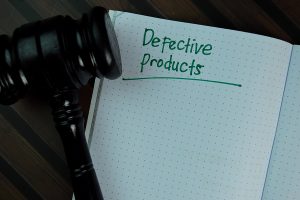Defective vs. Unsafe Products: What Is the Difference?
 Michael Babboni
Recalls
Unfortunately, it is not uncommon to become injured while using a product. Many people have been cut, bruised, burned, or more severely injured simply using products they purchased and trusted to work as advertised. In some cases, there may be grounds for a defective product claim. However, you need to know the difference between defective and unsafe products to see if you have the chance at compensation.
Michael Babboni
Recalls
Unfortunately, it is not uncommon to become injured while using a product. Many people have been cut, bruised, burned, or more severely injured simply using products they purchased and trusted to work as advertised. In some cases, there may be grounds for a defective product claim. However, you need to know the difference between defective and unsafe products to see if you have the chance at compensation.Unsafe Products
An unsafe product is one that can cause injury but is not actually defective. The danger of the product lies in its design and is typically an unsafe and dangerous product to use. Some people also refer to bicycles, ATVs, and sporting good products as unsafe products, but that doesn't necessarily mean you have a personal claim opportunity due to these products.
Defective Products
A defective product causes injury to a person as the result of faulty labeling, a design flaw, or defective manufacturing. In addition, the product is considered defective if its usability for its intended purpose cannot be followed through. In this case, there is legal context regarding safety for anything that renders the product not reasonably safe.
Three Types of Product Defects
Here are the three main types of product defects and information on how to recognize these defects:
• Design Defect: this is when the actual design of the product is faulty. Some design defect examples include a vehicle tire that blows out at certain speeds or a clothes dryer that becomes too hot and starts a fire.
• Manufacturing Defect: this usually applies only to a certain number of units of the product rather than all the products in the product line. An example of this is when a seatbelt is accidentally left out of a vehicle during manufacturing, or a product becomes contaminated while it is being sealed.
• Labeling Defect: this happens when a product is missing a critical warning label or instructions. It is then considered unsafe for normal use. An example of this is when a medication lacks warnings about specific drug interactions or fails to list the possible side effects.
Were You Injured by a Defective Product?
If you have been injured by a defective product and the accident was caused due to a faulty design, a defect during manufacturing, or a labeling defect, you may be able to file a defective product claim for compensation.
You can seek compensation to cover your medical bills, lost wages, pain and suffering, and other damages from the designer, manufacturer, or even the distributor of the product in question.
Florida law states you can hold the designers, manufacturers, suppliers, and distributors of a defective product liable for injuries suffered as a result of the product. The state also says that family members can file a claim and collect compensation on behalf of their loved one if they died as a result of the accident caused by the defective product.
Proving Liability in Defective Product Claims
To prove liability in a defective product claim in Florida, you need to prove that the product was being used as intended, the product was defective, you were injured or suffered harm, and that harm was caused due to the defect. For this, evidence is key.
Evidence you can submit includes the defective product itself, photos and videos documenting the injuries, the defect, or even the incident, medical bills, accident reports, witness statements, insurance documents, evidence like emails or memos showing the manufacturer knew of the defect, or marketing materials.
If you have been injured as the result of a defective product while using the product as it was intended and it was not just simply because it was an unsafe product, you may be entitled to compensation for those injuries.
Discuss your case with a qualified defective products attorney to see what you have to do when filing your claim. This is easier to do as long as you know the difference between a generally unsafe product and a product that is actually defective.
